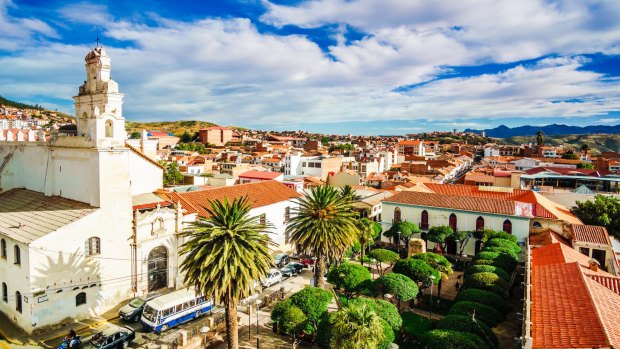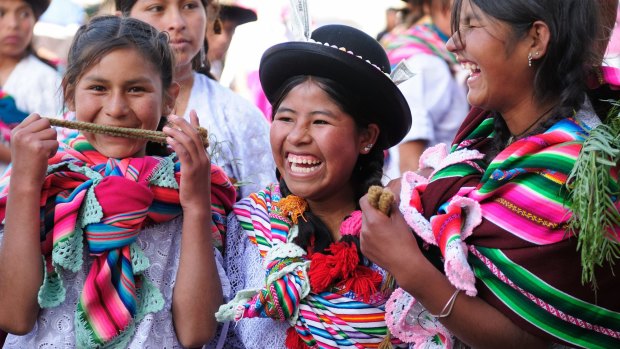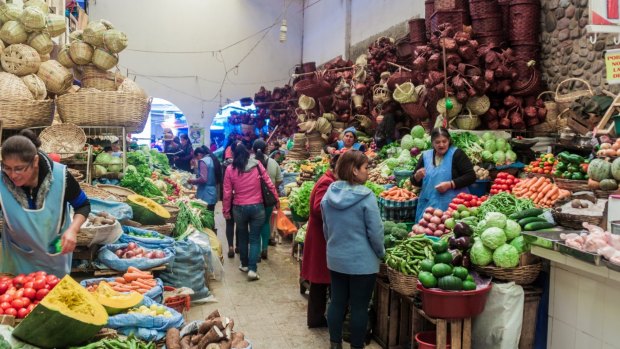This was published 6 years ago
Sucre, Bolivia: This elegant colonial city feels like a little slice of Europe
By Isobel King

At the height of the silver boom in the early 17th century, it's claimed that many of the world's richest men lived in Bolivia. You can see the legacy of wealth everywhere.Credit: Shutterstock
Arriving at the bus station in the dead of night was probably not the best introduction to Sucre. It had been a long haul from the salt flats of Uyuni and included a bungled attempt at the mining town of Potosi to jump ship and grab a share taxi for the remainder of the trip.
Let's just say that plan didn't pan out, and only served to add a couple of hours to the already lengthy bus journey. And now here we are trundling luggage along lonely, dark back streets on the city fringes looking for a taxi.
In Bolivia, you're warned to only take the official radio taxis but as novices, we hadn't yet distinguished the dubious beaten-up old bangers from the marginally newer official beaten-up old bangers. We later learned to identify radio taxis by their roof bubbles, which advertise the logo, telephone number and name of the company.

A festival in Sucre to celebrate the Virgin of Guadalupe. Credit: Shutterstock
After sizing up the drivers of several slow-cruising "taxis", we eventually trust the look of a wizened, kindly-faced driver, who piles our luggage into the back and spirits us into the night.
Things are looking up as we arrive at our city hotel, an utterly gorgeous converted villa that we cannot believe we've scored for less than $100 a night, after the dump we paid the same price for in Uyuni. It's just a couple of blocks from Sucre's grand central square, Plaza 25 de Mayo, a hive of activity at 11pm.
The square is the size of a city block, with paths, neat garden beds, park benches of chatting locals. It feels completely safe to stroll around at night.

A local market in Sucre.Credit: Shutterstock
Several of the city's most important and majestic buildings flank the square: the Catedral Metropolitana, a mix of baroque and Renaissance architecture; the Casa de la Libertad, where Bolivia's declaration of independence from the Spanish was signed in 1825 and is now a history museum; the grand Palacio Nacional; and Basilica de San Francisco, built by the Franciscan order in 1577 and later the seat of the national army.
On May 25, 1809, the Bolivian independence movement was started with the ringing of the bell of the Basilica – so hard it actually broke. Hence, the name of the square: Plaza 25 de Mayo.
The buildings aren't just historically significant; they're breathtakingly beautiful, especially seen by night for the first time, a blaze of uplights and downlights drawing out every detail of the dashing white Hispanic structures.
Many people mistakenly believe La Paz is the capital of Bolivia, perhaps misled by its sheer size, larger than life reputation and general mayhem. However, Sucre is the constitutional capital, where the Supreme Court is located. It was founded by the Spanish in 1538, and its architecture and ambience retain a strong colonial flavour. In 1991 it was declared a UNESCO World Heritage Site in recognition of its beauty and historical significance.
On a walking tour next day, I learn a lot more about Sucre's past and how it grew into the modern city it is today, in a country where the hallmarks of poverty are never far from view.
It feels like a neat little piece of Europe; unsurprisingly, it's a popular city for foreigners to come to study Spanish, and you'll find advertising posters everywhere, for private lessons and rooms to rent. It's home to one of the oldest universities in the world, the St Francis Xavier University of Chuquisaca, opened in 1624 and like nearly all the tourist landmarks, it's within walking distance of the main square.
It turns out Sucre's wealth originated from the silver mines of scruffy Potosi, 150 kilometres away by road. In fact, the city was originally named La Plata (silver) until 1840, when it was renamed in honour of the liberator Antonio Jose de Sucre.
At the height of the silver boom in the early 17th century, it's claimed that many of the world's richest men lived in Bolivia. Certainly, the silver mines bankrolled the Spanish empire.
Mining magnates preferred the temperate climate and lifestyle of Sucre to the dust and dirt of Potosi, so they settled here with their families, building mansions and funding infrastructure. While Potosi sits at an inhospitable 4000 metres, engulfed by the Andean mountains, Sucre is safely nestled in a valley, at 2800 metres.
You see the legacy of the wealthy everywhere. About 30 minutes from the centre of Sucre is the rather gaudy, Gothic-inspired La Glorieta castle, commissioned by mine and private bank owner Francisco Argandona and his wife Clotilde Urioste. They gained the honorary title of prince and princess, and by the late 19th century divided their time between Europe and Bolivia. The enormous Bolivar Park in the city centre was once a private park for the princess; the miniature "replica" of the Eiffel Tower was actually designed by French engineer Gustav Eiffel himself, its components shipped from Paris and assembled on site.
All of this history and wealth neatly explain why Sucre is the beautiful, well-planned, charming city it is today. However, like much of Bolivia, there's an underbelly. The country is tainted by its reputation as a major player in the cocaine trade, with all the associated problems that brings with it.
Those on our walking tour are keen to hear from our young, university-educated guide if the stories about Bolivian prisons housing cocaine laboratories are true. They'd obviously read Australian Rusty Young's Marching Powder , the book about Bolivia's notorious San Pedro prison, an underworld city unto itself.
Our guide goes one better, and says it's rumoured that inmates here in Sucre are let out at night on robbing sprees or to do organised hits, so the guards can share in the spoils.
He nods in the direction of a neighbourhood we pass on our bus up to a popular tourist lookout. "Even as a local, I would never venture there," he says, before reassuring us that Sucre is a very safe city, "but be sensible".
We arrive at Plaza Anzures, up among the narrow, cobbled streets of La Recoleta, just as the sun is setting, and the city below stretches out before us in a dusty pink and orange glow. It looks so much bigger from up here and you can clearly see the grid layout, a network of white buildings and terracotta roofs, stretching towards the mountains in the distance. I hear there's great hiking there, but unfortunately my schedule won't allow for that.
A busker is perched on a ledge under one of the arches, playing with gusto. It merges with a desolate violin wafting from the other end of the plaza. Down on the forecourt below us, there's a lively little bar scene laying down another soundtrack. I get the feeling Sucre is a place I could easily spend a couple of weeks in, peeling back its many layers.
FIVE MORE THINGS TO DO IN SUCRE
TREK OR WALK
Condor Trekkers is a not-for-profit company that offers hiking trips into the local mountains as well as an excellent three-hour city walking tour. It's office is one block up from the central plaza and its founder is Randall Howlett, a spirited Aussie who directs profits towards philanthropic projects in Bolivia. The city walking tour includes the history of Sucre, a market tour, tastings and a quick bus trip up to La Recoleta, where the tour finishes in a local bar. See condortrekkers.org
SHOP
Just down from the main square is the enormous, undercover Mercado Campesino market. It has food, clothes, knick-knacks and a terrific food court on the top floor. Definitely worth a visit, if only for the bustling atmosphere and local immersion. The stall owners generally do not like impromptu photos, so you'll need to ask nicely. See sucrelife.com
TOUR A CEMETERY
From its rows of stacked graves, lining the paths like miniature apartment blocks, to ornate headstones and huge mausoleums, this peaceful cemetery provides an intriguing window into Sucre's burial rituals. Mature trees, manicured lawns and garden beds provide a peaceful setting in which to sit on a bench and indulge in some people watching. The cemetery is about a 15-minute walk from the main plaza. sucrelife.com
EAT
Condor Cafe is an organic eatery attached to the Condor Trekkers tour company, and after almost a week of staple Bolivian fare, it was a welcome find. Hearty soups, fresh salads, bread and simple, healthy, tasty meals had us back every day. Calle Calvo 102 (corner with Bolivar), Sucre.
DRINK
Cafe Florin is a lively bar with fast reliable Wi-Fi (don't underestimate the significance of that in Bolivia) and a selection of pub-style meals. I had an unbelievably good Thai green curry. Seefacebook.com/Cafe.Florin
TRIP NOTES
MORE
FLY
Qantas has non-stop flights four times a week, Sydney to Santiago, Chile. LATAM has three non-stop flights a week Melbourne to Santiago, with onward connections to Bolivia. See qantas.com.au; latam.com
STAY
Mi Pueblo Samary boutique hotel is a converted colonial mansion set around a courtyard garden with a buffet breakfast room on the top floor with views. Rooms are from $80, including breakfast. See samaryhotel.com
Isobel King travelled at her own expense.
Sign up for the Traveller Deals newsletter
Get exclusive travel deals delivered straight to your inbox. Sign up now.